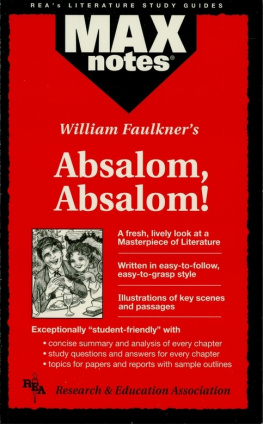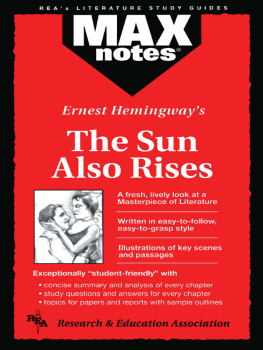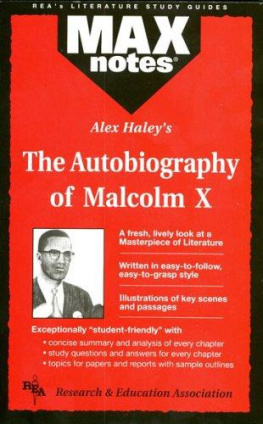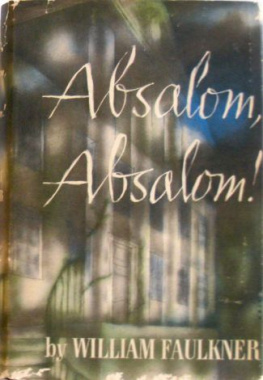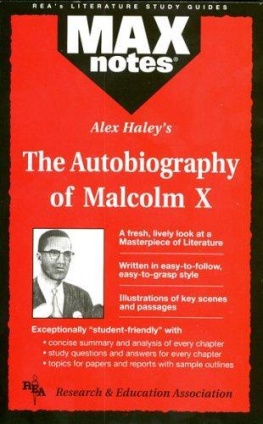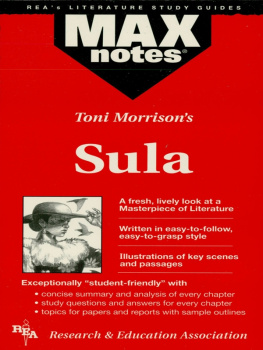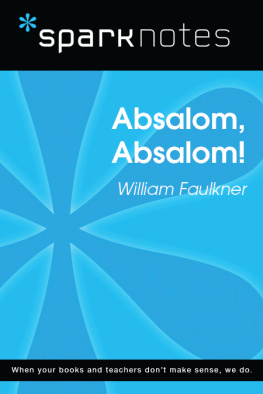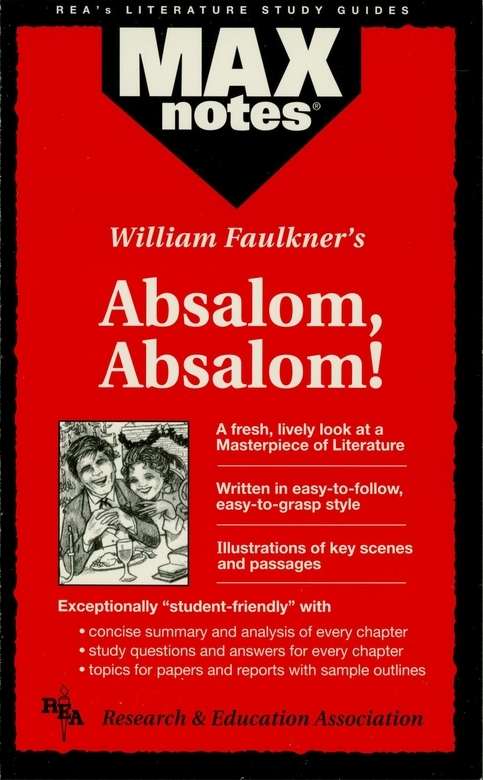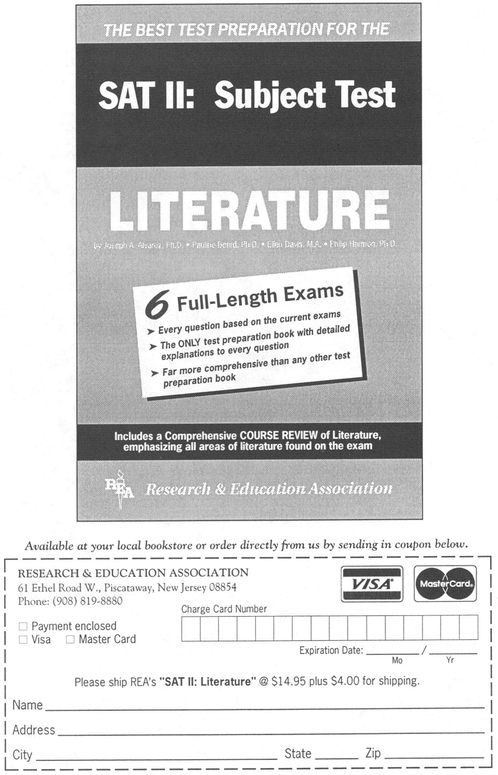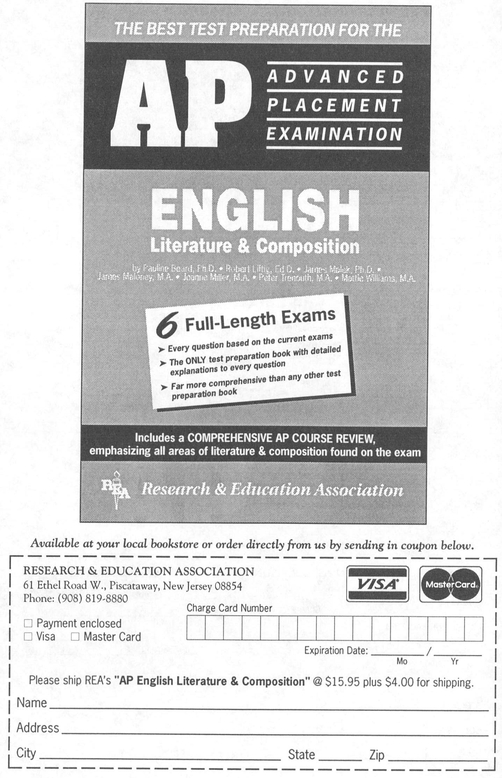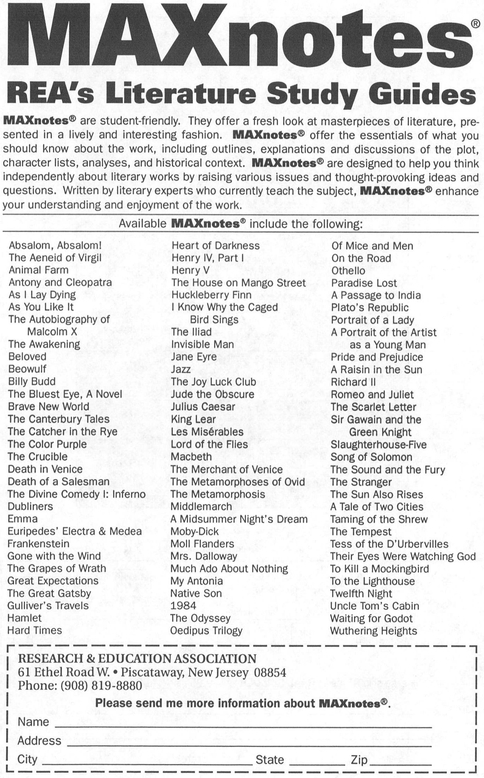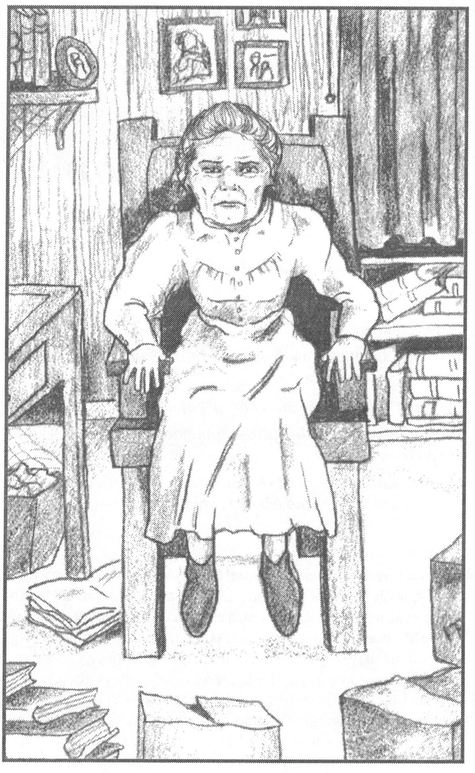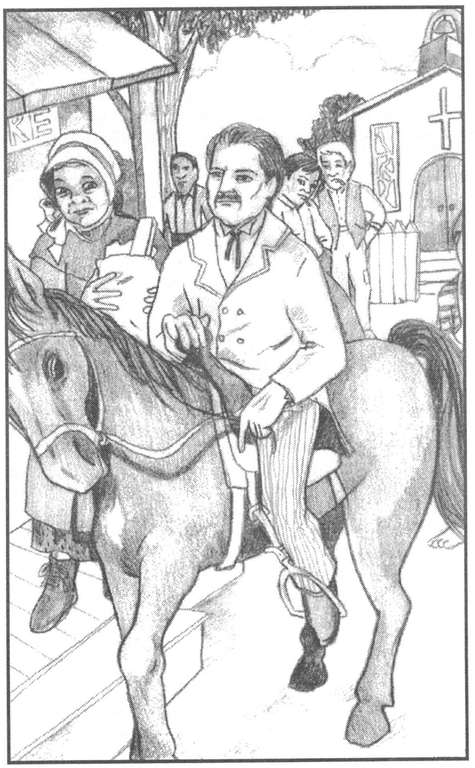Miss Rosa Coldfield: a minor figure in the Sutpen myth; a major narrator in the novel
Mr. Compson: Quentins father, a major narrator in Absalom, Absalom!
Thomas Sutpen: the frontiersman who founded the Sutpen clan; the patriarch around whom the novel is centered
Summary
The novel Absalom, Absalom! begins with a starkly evocative (and typically Faulknerian) scene: Miss Rosa Coldfield, an old Southern lady, and Quentin Compson, a confused young Southerner, are sitting in a dusty, airless, and timeless room, talking. Miss Rosas legs are so short they barely touch the floor, and Quentin, a college student, does not know why he is there. Nevertheless, the old lady rambles on, telling Quentin the history of the Sutpen clan in the town of Jefferson, Mississippi. Quentin obediently listens to the tale.
Most of the novel is a third or fourth-person account of the events surrounding Thomas Sutpen and his plantation, Sutpens Hundred. We hear the viewpoints of Miss Rosa, Quentin, Quentins father Mr. Compson, and various townspeople as well. From all this evidence, we are left to re-construct the tale as best we can.
Later in Absalom, Absalom!, Quentin asks his father why Miss Rosa chose him to tell the tale; Mr. Compson answers that it is because his father, Quentins grandfather General Compson, was the first (and only) man to befriend Thomas Sutpen when he appeared suddenly and unexpectedly in the town of Jefferson. Since that day, the Sutpen family, and thus Miss Rosas family, has relied on the Compsons as historians and friends.
Miss Rosa talks on and on, seemingly without sense. Her narration is interwoven with Quentins own thoughts about the subject, and about Miss Rosa herself. Miss Rosa haphazardly tells the story of Sutpens marriage to her sister Ellen, and their two children, Judith and Henry. Throughout her narrative, Miss Rosa refers to Thomas Sutpen as a demon or ogre thus displaying her hatred of him.
Miss Rosa hated Thomas Sutpen for a variety of reasons. According to her narration, he came out of nowhere and wasnt even a gentleman, and yet he had the power to build a plantation and to meet and marry her sister. Miss Rosa might have forgiven him for those things, but she would never forgive him for what he did later, when he proposed marriage to her and then added an insulting stipulation.
Thomas and Ellen Sutpen had two children, Judith and Henry, but Sutpen still led a wild, savage life. He invited the towns men to his barn to bet on fights between slaves. He even joined in the fights himself. One night Ellen surprised him in a fight with his three childrenJudith, Henry, and Clytie (the daughter of Sutpen and a slave)watching. Not only was the patriarch fighting a slave, but both were naked to the waist and gouging at one anothers eyes as if their skins should not only have been the same color but should have been covered with fur. According to Miss Rosa, this is the point at which Ellen Sutpen discovers what kind of man she has marrieda savage. Chapter One ends with this scene.
Analysis
Some of the main thematic elements of Absalom, Absalom! are revealed within the first sentences of the novel. Faulkners themes of death, the confusion of the past with the present, and the inevitability of history are demonstrated in the very first words that he writes. In the initial image that Faulkner draws of Miss Rosa talking to Quentin, he writes:
they sat in what Miss Coldfield still called the office because her father had called it thata dim hot airless room with the blinds all closed and fastened for forty-three summers because when she was a girl someone had believed that light and moving air carried heat and that dark was always cooler...
Immediately the reader is told that this is a story made up of other stories: Miss Rosa and Quentin are not only sitting in an office, but what was still called an office, since Mr. Coldfield once had called it that. With these few words, we realize that the ghosts of the past will be important throughout the text.
There is also an immediate indication that this is a story made up of myths. For instance, the blinds are shut, not just to keep out the heat, but because someone once said that air carried heat. By explaining it in this complex way, Faulkner is suggesting that this is a myth (that air carries heat), and may or may not be true. The same goes for all of the facts in this novel: they are recreations of myths told, time and time again, by people long dead or nearing death.
Faulkner also uses many adjectives without connecting commas to stress the mood, as in this description: a dim hot airless room. This is an example of how he uses language and the tools of poetry to reinforce his theme. If you read dim, hot, airless room, with correct punctuation, you leave a pause between the adjectives. But, if you read it as Faulkner wrote itdim hot airless roomyou end up saying it as if you were breathless, as you would be in such a place. One of the reasons for the great difficulty in reading Absalom, Absalom! is that it is in many places a prose poem of magnificent complexity.
That first sentence continues its poetic description of the room:
which (as the sun shone fuller and fuller on that side of the house) became latticed with yellow slashes full of dust motes which Quentin thought of as being flecks of the dead old dried paint itself blown inward from the scaling blinds as wind might have blown them...
Quentin is looking at dust motes as if they were flecks of old paint. Again, we are warned that in this dead, quiet world, reality is in the eyes of the beholder.
Faulkners dense, modernistic style is immediately evident here. He is influenced by the modernist novelist James Joyces stream-of-consciousness technique, and by the poetry of T S. Eliot. Like Joyce and Eliot, Faulkner omits punctuation, uses compound adjectives, makes up words (like nothusband), and continually sacrifices clarity to the rhythms and cadences of poetry. Consequently, it is important, especially on a first reading, to read the text closely, out loud if possible. This will make understanding the novel much easier.

